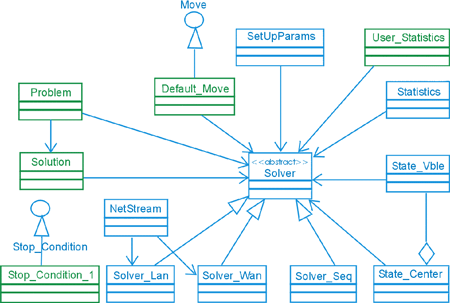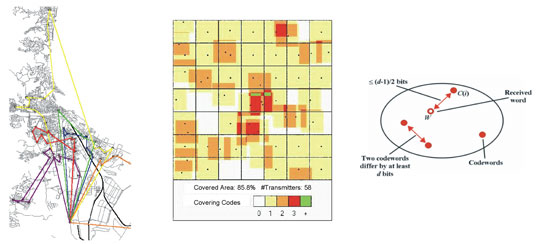|
|||||
Solving Complex Problems with Advanced Techniquesby Enrique Alba The area of complex problems and modern solving techniques is one of the multiple research lines in progress at the University of Málaga. It has been addressed in the research projects ‘MALLBA’ and ‘TRACER’. Complex problems - those that can only be solved in non-polynomial time - are becoming common in all the domains of our lives: telecommunications, economics, bio-informatics, industrial environments etc. In these and other fields of research it is often essential to model and solve optimisation, learning, or searching tasks for applications that do not admit an easy formulation. In fact, it is often the case that the problem at hand is non-differentiable, has a large number of constraints or objectives, does not admit contour conditions, or is ill-defined. Also, most real-life problems show a high degree of inter-parameter linkage (epistasis), many locally optimal solutions (multimodality), and present a high dimension. All these ideas were included in the recently completed MALLBA project (2000-2003), and are being extended in TRACER (2003-2005), a new set of proposals for dealing with complex problems. The MALLBA project was an effort to develop an integrated library of skeletons for optimisation containing exact, heuristic, and hybrid techniques. One important outcome of the project was the MALLBA library, which is publicly available at http://neo.lcc. uma.es/mallba/easy-mallba. The three target environments considered for solving complex problems are sequential, LAN, and WAN computer platforms. The list of modern techniques we consider in our studies with MALLBA and TRACER includes evolutionary algorithms, simulated annealing, memetic algorithms, ant-colony algorithms, scatter search, and a set of variations on well-known techniques like branch-and-bound, randomised local search, etc. Software skeletons are somewhat similar to simplified software patterns. In MALLBA, software skeletons for all these algorithms have been built with a common internal and public interface. This permits fast prototyping and transparent access to parallel platforms. MALLBA skeletons distinguish between the concrete problem to be solved and the solver technique. Skeletons are generic templates to be instantiated by the user with the features of the problem. Much work has been put into designing reliable, general algorithms, and a permanent interest exists in using software engineering concepts for correct design. All the knowledge related to the solver method (eg parallel considerations) and its interactions with the problem are implemented by the skeleton and offered to the user. Skeletons are implemented by a set of required and provided C++ classes that represent an abstraction of the entities participating in the solver method. Provided classes implement internal aspects of the skeleton in a problem-independent way. The most important provided classes are 'Solver' (the algorithm) and 'SetUpParams' (configuration parameters). On the other hand, required classes specify information related to the problem. Each skeleton includes the 'Problem' and 'Solution' required classes that encapsulate the problem-dependent entities needed by the solver method. Depending on the skeleton, other classes may be required. Therefore, the user of a MALLBA skeleton need only implement the particular features related to the problem. This speeds up considerably the creation of new algorithms with minimum effort, especially if they are built up as combinations of existing skeletons (hybrids). Figure 1 shows an example of design for a simulated annealing algorithm.
The focus of MALLBA was mainly in creating the software and hardware infrastructure (especially an operative WAN) for later developments, while accounting for parallelism and hybridisation. Many application domains have been addressed within MALLBA, but at the same time, many important issues concerning the problems and the techniques themselves were deferred for TRACER. In the new TRACER project (http://tracer.lcc.uma.es) therefore, powerful and robust algorithms are being developed in close connection with the Internet. Again, in all our research we pay close attention to efficiency and to the software design aspects of the algorithms. This project represents a joint effort of five groups in Spain, coordinated from the University of Málaga and devoted to proposing solutions and algorithms (in C++ and also in Java) that outperform existing cutting-edge optimisation techniques. We are working on two fronts: achieving results having the best-so-far accuracy for the considered problems, and developing algorithms for these that show the best-so-far numerical efficiency. At the end of the project we expect to provide the research community with leading algorithms and accurate results, thereby enhancing scientific knowledge on optimisation. Some successful case studies include the following:
We are also working on other topics like bio-informatics or dynamical optimisation (DOP). However, besides working on the algorithmic aspect, we are aware of communities of users demanding solutions for their own problems. This is why we plan to release a public Internet service that will help researchers to solve complex problems by feeding them (written in Java, C++, and other languages) into a client/server system and then selecting one solver from an assorted set of algorithms to obtain a solution with a short round-trip time and low effort. Any kind of comment, idea, or collaboration is welcome. Link: Please contact: |
|||||




